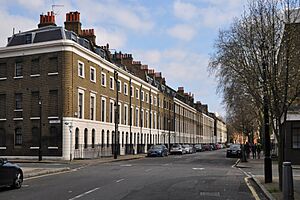Newington, London facts for kids
Quick facts for kids Newington |
|
|---|---|
 Trinity Church Square forms part of a conservation area |
|
| Population | 14,136 (2011 Census. Ward) |
| OS grid reference | TQ325795 |
| London borough | |
| Ceremonial county | Greater London |
| Region | |
| Country | England |
| Sovereign state | United Kingdom |
| Post town | LONDON |
| Postcode district | SE1, SE17 |
| Dialling code | 020 |
| Police | Metropolitan |
| Fire | London |
| Ambulance | London |
| EU Parliament | London |
| UK Parliament |
|
| London Assembly |
|
Newington is a lively area in South London, located just south of the River Thames. It is part of the London Borough of Southwark. Long ago, it was an old parish and an important place for the county of Surrey's administration. Today, a building that used to be the County of London Sessions House (like a main court) is now the Inner London Crown Court.
Contents
History of Newington
What's in a Name?
The name "Newington" means "new farmstead." This refers to a newer part of the Walworth manor, which was like a large estate. The area was on an old Roman road that connected London to places like Chichester in West Sussex. Because it was close to London, many stalls, stables, and shops appeared there over time.
Newington was first mentioned in old records around the time of King Henry III (between 1198 and 1242). An old book called the Testa de Nevill said that "the queen's goldsmith holds... one acre of land in Neweton." Later, in 1313, it was called "Newington juxta London," meaning "Newington near London."
You can still see the name "Newington" in street names like Newington Causeway and Newington Butts. There's also a park called Newington Gardens, which is where an old prison, Horsemonger Lane Gaol, used to be. Today, Newington is also the name of a local area (called a ward) within the London Borough of Southwark.
How Newington Grew

For a long time, Newington was mostly a farming village with few people. There was some small industry, like making clay pipes for smoking tobacco. In William Shakespeare's time, there was even a theatre called Newington Butts.
Newington became more important after the Westminster Bridge was built in 1750. This bridge and other improvements to London Bridge meant new roads were needed to connect different parts of London. These roads, like Westminster Bridge Road and Borough Road, helped traffic from the fancy West End travel south without going through the busy City of London.
All these new roads met at a place where there was a blacksmith's shop and an inn called Elephant and Castle. This name then became famous for the whole area. New roads brought new chances for building. A local landowner, Henry Penton, started selling parts of his farmland. In the 1800s, many houses were built. The Trinity House Newington Estate became a nice place to live, and many of those buildings are still there today.
The area grew even more when railway lines arrived. The London, Chatham and Dover Railway opened a station at Elephant and Castle in 1863. Later, in 1890, the City and South London Railway (now part of the Northern line of the London Underground) opened stations in the area. In 1906, the Bakerloo line also ended at Elephant and Castle.
Local Government
The old parish of Newington St Mary was part of the Brixton Hundred in Surrey. Before elected councils were created in 1889, local judges (called magistrates) were in charge of making sure local rules were followed. When a new court building was built in Newington Causeway in 1792, Newington became the main town for Surrey until Kingston upon Thames took over in 1893.
In 1855, Newington became part of the Metropolitan Board of Works, which helped manage London's growth. In 1889, it became part of the County of London. Then, in 1900, local government was changed again, and Newington became part of the Metropolitan Borough of Southwark. The old parish was finally removed in 1930.
Today, Newington is a ward (a local area for voting) within the London Borough of Southwark. It is also part of the Parliamentary area called Bermondsey and Old Southwark.
Churches in Newington
The old parish church, dedicated to St Mary, was part of the Diocese of Winchester for many years. As more people moved to Newington, many new churches were built. From 1826 onwards, ten new parishes (areas served by a church) were created. These included:
- Holy Trinity, Newington (1826)
- St Peter, Walworth (1826)
- St Paul, Newington (1857)
- St John, Walworth (1860)
- All Saints, Newington (1866)
- St Matthew, Newington (1868)
- St Mark, Walworth (1870)
- St Stephen, Walworth Common (1871)
- All Souls, Grosvenor Park (1871)
- St Andrew, Newington (1877)
Famous People from Newington
Many famous people were born in Newington:
- The scientist Michael Faraday, known for his work with electricity, was born in Newington Butts in 1791.
- Charles Babbage, who helped create the idea of the first computing machine, was born on Walworth Road.
- William Jowett, a missionary and writer from the 1800s, was born in Newington in 1787.
- The English artist Samuel Palmer was born in Surrey Square in 1805.
- William Swainson, an expert on birds and a natural history artist, was born here (1789–1855).
- Tom Smith (1823–1869), who invented the Christmas cracker, was also born in Newington.
Newington Geography
Nearby Places
Nearest Tube Stations
- Kennington
- Borough
- Elephant & Castle
- Lambeth North
- London Bridge
Nearest Railway Stations
- London Bridge
- Elephant & Castle
- Waterloo
- Blackfriars
See also
 In Spanish: Newington (Londres) para niños
In Spanish: Newington (Londres) para niños


